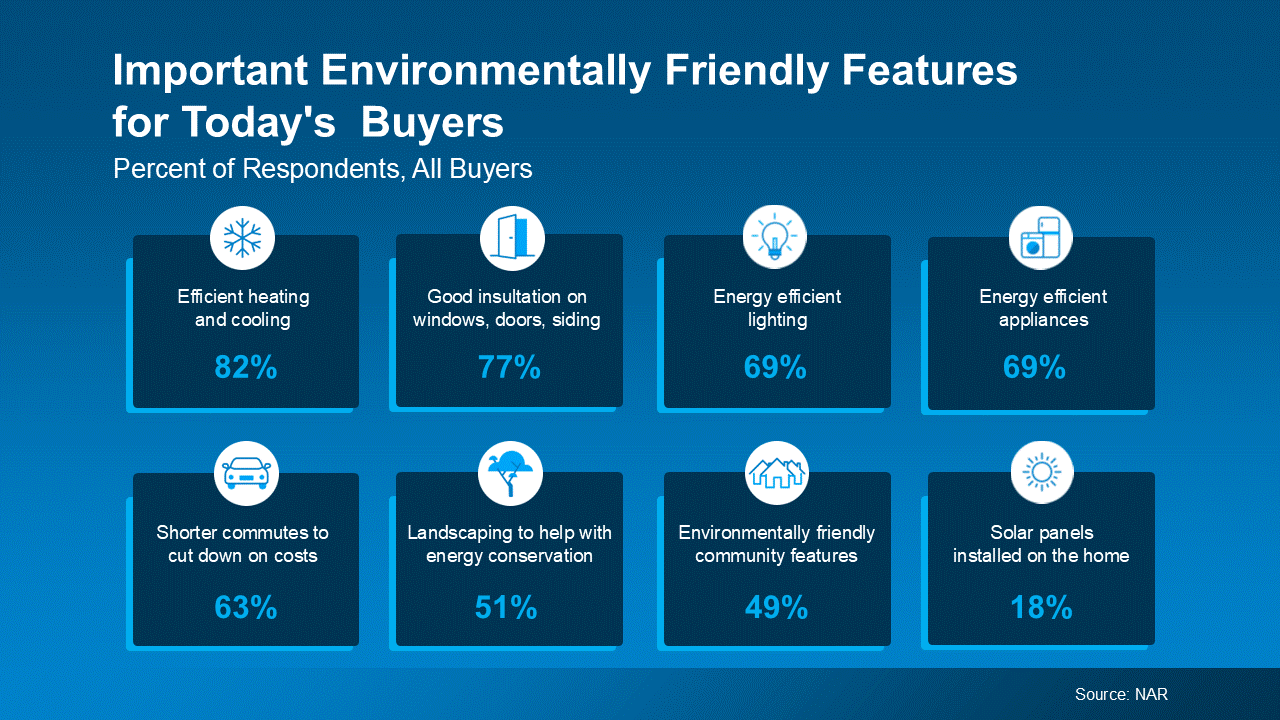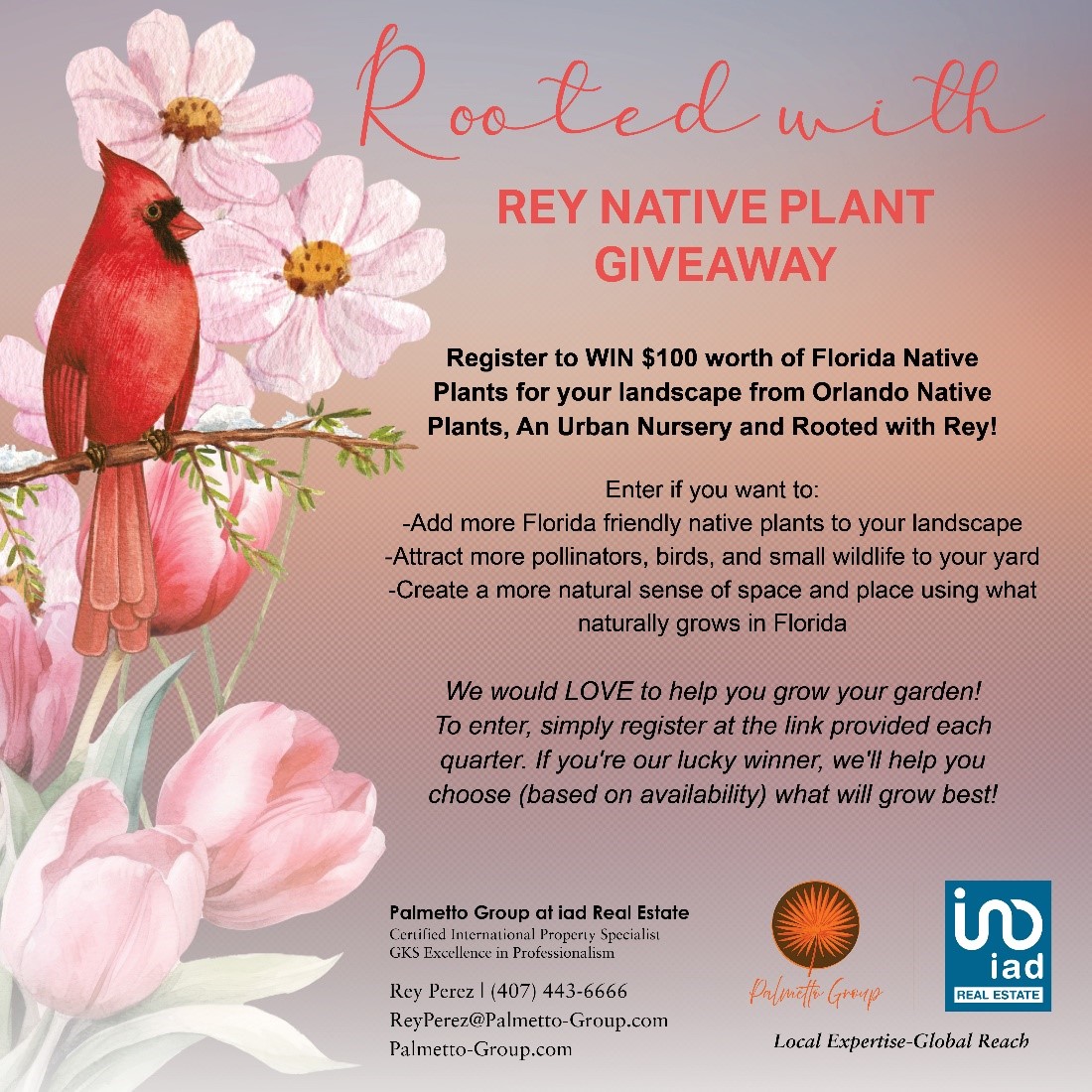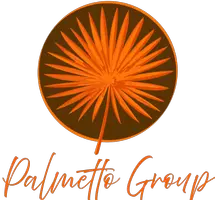
Welcome to my monthly Rooted with Rey Newsletter!
Cheers to the New Year! As we step into 2025, it's the perfect time to reflect on the successes of the past year and embrace the opportunities that lie ahead. A new year brings a fresh slate, a chance to set intentions, chase dreams, and explore new possibilities. Whether you’re focusing on personal growth, professional goals, or simply finding joy in the little moments, this year is full of promise.
Here’s to making 2025 a year of progress, connection, and fulfillment. Let’s dive into this month’s updates and start the journey strong!
Here you will find the following info:
Orlando Market Report
How Eco-Friendly Features Can Boost Your Home’s Value
Living in Spain – Random Observations of Spanish Culture
Native Plants: A Path to Renewal, Respite, and Habitat
Pop Up Sales at Orlando Native Plants
Quarterly Native Florida Plant Contest
Rooted with Rey 1st Wednesday Coffee Talk
Discover Final Offer
I hope you enjoy your month wherever you call HOME and feel free to reach out to me anytime!
Orlando Market Report
Click Here to Watch the ORRA State of the Market – November 2024 Video
How Eco-Friendly Features Can Boost Your Home’s Value

Selling your house? Or just looking to increase the value and appeal of your home for when you do? Here’s something you should know – homebuyers are increasingly looking for homes with environmentally friendly features.
What Energy Efficient Features Do Buyers Want?
According to recent data from the National Association of Realtors (NAR), when buyers think about eco-friendly features, they’re looking for (see visual below):

- Heating and cooling costs: 82% of buyers consider heating and cooling costs to be one of the most important factors when looking for a home. And efficient heating and cooling systems with programmable thermostats can significantly lower monthly energy bills.
- Windows and doors with proper insulation: These help maintain comfortable indoor temperatures without overworking the HVAC system, which turns into saving on energy bills.
- Energy-efficient lighting and appliances: These can save money on utility bills and reduce a home's overall energy use too.
- Commuting costs and environmentally friendly community features: Living in a community designed with energy-saving amenities and shorter commutes can reduce expenses and environmental impact.
- Landscaping for energy conservation: Strategically placed trees and shrubs can lower cooling costs in the summer.
- Solar panels: Solar panels can also provide long-term savings and are an attractive feature for eco-conscious buyers.
The common theme? Environmentally friendly features are popular with buyers because they help them save money and make homes more comfortable to live in. But making some of these updates before you sell your house doesn’t just benefit buyers – it's worthwhile for you too.
How Green Features Benefit You
If your appliances or systems are aging, upgrading them now means you can enjoy the savings and comfort while you’re still living in the home.
The U.S. Department of Energy has introduced Home Energy Rebates, which can provide households with up to $14,000 in savings on energy-efficient upgrades. This includes insulation, duct sealing, heat pumps, and more. These rebates make it more affordable than ever to improve your home’s efficiency.
Then, when you decide to sell, you’ll reap the rewards again. Energy-efficient homes stand out in a competitive market and appeal to the growing group of environmentally conscious buyers.
Studies also show that homes with energy-efficient upgrades, like those with high-efficiency HVAC systems or modern insulation, are more desirable for buyers- and they generally net a higher price. Research from Freddie Mac found that homes with high energy-efficiency ratings sold for 2.7% more on average than homes without these upgrades.
Work with a Real Estate Agent to Maximize Value
Not sure which upgrades to prioritize? That’s where a local real estate agent comes in. They can help you identify the eco-friendly features that buyers in your area value most. Whether it’s adding Energy Star appliances or improving insulation, they’ll guide you in making the best choices for your house and your budget.
Bottom Line
Making environmentally friendly upgrades can pay off in more ways than one. You can enjoy saving on energy bills and improved comfort now. Additionally, you’ll have the satisfaction of knowing you’re contributing to a more sustainable future while adding value to your home. Ready to learn more about how you can make your house stand out? Let’s connect.
Living in Spain – Random Observations of Spanish Culture
By Will Halpern iad Spain Real Estate Rep with the Palmetto Group
Life in Spain is different than the U.S. Not always better, but very often different. Here are some random observations:
- Most people in Spain live in apartments (small apartments by US standards). So, people usually meet up with friends and family in public, at restaurants, bars or parks. This may explain why there are so many restaurants and bars in Spain! (According to one survey, Spain has the most bars per capita in the world!) And they are very busy, day and night.
- Drinking alcohol with meals is very common, including lunch. The "menu of the day" usually includes (at least) one glass of wine or beer.
- Spaniards rarely do anything alone and you will often see large groups of friends and family out and about, even if it is just for a walk in the park or a trip to the grocery store.
- Since apartments are small, there are public playgrounds everywhere. Kids are welcome in all public places, and it is very common and natural to see kids playing while the parents are socializing nearby (often in the outdoor bar right next to the playground!).
- Spaniards can seem standoffish in public (it is rare to say "hello" or "how ya doing" to strangers on the street). However, it is a different story once you get to know someone. A quick coffee can easily lead to an entire day of shopping, eating and being included in whatever activities they (and their families) are up to that day, whether it a trip to the beach or a wedding. ;) It may sound cliche, but once you are friends with a Spaniard, you are truly a member of the family.
Native Plants: A Path to Renewal, Respite, and Habitat
By MAC Camacho-Viera, Florida Master Gardener Volunteer Class 2024
In a world dominated by concrete and manicured lawns, native plants offer a return to ecological balance. They are more than greenery—they bring renewal, offer respite, and create vital habitats.
Renewal begins with native plants. Unlike ornamental varieties, they restore soil health, improve water retention, and support biodiversity. Imagine a yard alive with butterflies, moths, flies, beetles, and lovebugs. Lovebugs, often misunderstood, enrich the soil as larvae and pollinate wildflowers as adults. Hoverflies, another unsung hero, pollinate crops and wildflowers while controlling pests like aphids.
Small steps make big impacts. In the southeastern U.S., planting coreopsis (Coreopsis spp.) or goldenrod (Solidago spp.) supports pollinators. Native grasses like wiregrass (Aristida stricta) or perennials such as spotted beebalm (Monarda punctata) attract a diverse range of species while conserving water and reducing urban heat.
Respite is the gift native gardens provide for people and wildlife alike. The hum of insects, flashes of butterfly wings, and darting hummingbirds create a calming retreat. Adding water dishes, open soil for ground-nesting insects, or night-blooming flowers like evening primrose (Oenothera biennis) enriches the garden’s beauty and utility. These spaces become places of mindfulness, connection, and restoration.
Habitat is the lifeline native plants offer. Monarch butterflies rely on milkweed (Asclepias spp.), while hummingbirds seek nectar from coral honeysuckle (Lonicera sempervirens) and cardinal flower (Lobelia cardinalis). Pollinators like beetles, flies, and moths thrive alongside insects sheltering in native grasses or finding food on goldenrod.
Native plants ripple benefits beyond individual gardens. They filter stormwater, reduce flooding, and stabilize soil, creating healthier communities. By choosing these plants, we ensure wildlife can flourish while addressing broader ecological challenges like biodiversity loss and climate resilience.
Integrating native plants is an act of stewardship that benefits all. Misconceptions about their maintenance often overshadow their beauty. Plants like purple coneflower (Echinacea purpurea) and black-eyed Susan (Rudbeckia hirta) combine ecological function with polished aesthetics, requiring less water and care than traditional ornamentals.
But native gardening offers more than ecological rewards—it nurtures a sense of self-renewal. Tending to a native garden allows us to reconnect with the cycles of life, fostering mindfulness and a deeper connection to the earth. In caring for the land, we find we are also caring for ourselves.
Each native plant is a step toward a thriving ecosystem and a healthier planet. Together, we can restore the wild—one plant, one choice at a time.
Let’s start today.
Pop-Up Sales at Orlando Native Plants

Happy New Year 2025!
We look forward to sharing new offerings and services in the coming year.
Join Us for a Pop-Up Sale at Orlando Native Plants!
Saturdays | Jan. 4th and 25th
Sundays | Jan. 5th, 12th, and 19th
Boutique Nursery Location: just off Mills, at corner of Lake Highland and Portland
1201 Portland Ave Orlando FL 32803
Let us know your Florida Native plant wants, and needs…
MAC The Native Plant Concierge, is at your service! 😀
* Native Plant Landscape Maintenance service
* Purveyor of Florida Native Plants
Florida Master Gardener/Florida Master Naturalist
Quarterly Florida Native Plant Contest
ENTER TODAY!
Click Here to Register for Your Chance to WIN!

Follow Me on social media!
Rooted with Rey | Coffee Talk | Monthly event on the 1st Wednesday of Every Month
Click Here to RSVP for February’s Coffee Talk!

Discover Final Offer









